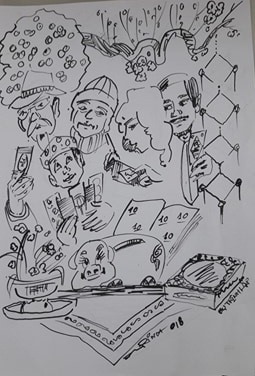 Talk Around Town
Talk Around Town

Lunar New Year has past, and we’re back to normal days of work and school. But one Tết issue remains: who gets to keep the lucky money, and for what purpose can it be used?
 |
| illustration by Trịnh Lập |
By Nguyễn Mỹ Hà
Lunar New Year has past, and we’re back to normal days of work and school. But one Tết issue remains: who gets to keep the lì xì or lucky money, and for what purpose can it be used?
In the economically difficult days before the policy renewal started in mid-1980, the amount of lucky money was tiny, but it gave children great joy to receive it.
Common practice then was to give the money all to the mother, who shops for the family’s everyday needs. And the then-popular reasoning that our generation accepted without questioning was that the parents had to give lucky money to other children, so they had to keep the kids’ money to pay for them.
In better economic times, children raise their voices to defend their claim to what they believe belongs to them. “I want to keep my lì xì money this year,” declared my 14-year-old firmly. “I would like to buy my necessities online and with my Tết lucky money.”
Now the question is, to whom does this lucky money really belong? Until last year, my daughter still entrusted all her lucky money to us, her parents. Now she is making a bold assertion of a right to keep something private from us.
Parents have many different answers to the question. In part, the answers depend on the family’s economic status. Some parents see lucky money as a chance to teach their children about how to save and use money, and some think it’s still too early to do that.
A mother of two girls under the age of 10 says the money must be given to the parents because they had already given money to other children and they needed it—the same argument used in the 1980s.
Some other parents say it belongs to the children, but the parents need to keep it and advise their kids on how to use it effectively. Fair enough.
Another mother of two college-age youths said she used to collect both of her children’s lucky money and put it in a bank on a 10-year children’s saving rate, so it would be ready for the children’s use in the long run.
But if you ask the children this same question, the answers vary even more. For short-term and practical use, a teenage boy who plays basketball would say, “It’s my money, and I’d like to buy new shoes with it.”
“I’d like to save up and get a puppy for myself,” says another girl. My teenage girl wanted to pay for her dance class, buy a lipstick and be able to have breakfast one day a week at the school canteen.
Children think in terms of what they like and want at the moment. Parents think in terms of what to feed them and teach them in the long run.
Of course, there’s a generation gap here. The gap can’t always be bridged.
This issue goes beyond Việt
There have been no court cases regarding lucky money for children in Việt
My family finally came to an agreement, quite fairly accepted by all sides: Kids’ lucky money belong to them. They put it in a book and if they want to spend it on something, the request must be approved as reasonable by one of the parents, and the other works as safe-keeper.
My fourth-grader’s teacher assigned the whole class to write an essay about their plans to use their lucky money. And the responses she got included those who said they would entrust the money to parents for buying food and paying school fees—and for giving back to other children. “It’s like a cycle,” writes one 10-year-old, “and I don’t like this very much.”
Another girl wrote, "I love receiving lì xì for the New Year not for the money value, but it means the feelings of our bigger family’s care for me
“What did you write in your essay, dear?” I asked my 10 year-old. “I would like to keep it as my investment for my slime business,” she said.
Caught up in the slime wave that has swept the world in recent years, she had learned how to make her first slime from her sister’s friend and developed ever since. She’s talking about starting an online slime business with herself as owner and hiring her older sister to work as manager.
She’s made a variety of clear slimes, butter slimes and cloud slimes and given them names such as the Witch Husband slime and Diamonds in Polluted Water Slime. She taught a Vietnamese friend from
She’s been sharing tips over her latest slime with her best kindergarten friend who’s been under treatment for leukemia in
Slime, as useless and a waste of time and money as I think, has united children across borders and languages and brought them so much joy.
A true slime aficionado feels great upon hearing the cracking sounds when one kneads a slime bun.
For our neighbourhood’s Lunar New Year Party, my daughter and her best friend had prepared a giant slime dance and show, but withdrew at the last minute because they were quite shy. Her giant slime clip got quite a few likes and applause from her mom’s friends.
Murmuring into my ear after I read her bedtime story, she asked, “Mum, if you get to go to the mall and get something for yourself this weekend, what would you get?”
Her words melted my heart, and a tear blurred my eyes. — VNS




